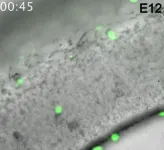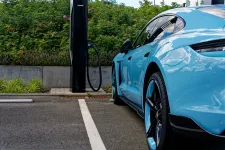(Press-News.org) A team from the Nagoya University Graduate School of Medicine in Japan has uncovered new information about how microglia, the resident immune cells in the brain, colonize the brain during the embryonic stage of development. Although erythromyeloid progenitors (EMPs) were previously thought to divide into either microglia or macrophages, the group found that macrophages that enter the brain primordium —the brain in its earliest recognizable stage of development— can become microglia at later stages of development. These findings demonstrate the plasticity of these cells and suggest a novel approach to combat diseases affected by microglial imbalances, such as fetal brain dysfunction. Their study was published in Cell Reports.
In addition to neural lineage cells, the brain contains other types of cells, such as immune cells and vascular cells. These different cells work together to maintain optimal brain function. Among the immune cells of the brain, microglia are important for maintaining the health and function of the central nervous system.
During embryonic development, EMPs differentiate into a variety of cell types, including macrophages and microglia. It was previously reported that segregation of EMPs into these two cell types usually occurs early in embryonic development in the yolk sac.
Using newly established intravital imaging system and cell-tracking methods, research by Lecturer Yuki Hattori (she/her) and Professor Takaki Miyata in the Department of Anatomy and Cell Biology; Professor Hiroaki Wake and Lecturer Daisuke Kato in the Department of Anatomy and Molecular Cell Biology; and Associate Professor Hiroyuki Konishi in the Department of Functional Anatomy and Neuroscience, Nagoya University Graduate School of Medicine, in collaboration with Okayama University, Kyushu University, and Freiburg University demonstrated that brain microglia are not only derived from yolk sac EMPs early in development but also supplied later during brain development by conversion from macrophages.
A type of macrophage called an intraventricular CD206+ macrophage, which is found along the inner surface of the cerebral wall, frequently enters a brain area called the pallium during the embryo’s development. Subsequently, these infiltrating macrophages differentiate into microglia in response to surrounding environmental factors in the brain. Dr. Hattori calls this the “additional route” in the brain that supplies some microglial populations.
To confirm their findings, the researchers transplanted macrophages into the brain’s ventricles. Surprisingly, intraventricular cells near the brain wall retained their macrophage properties, while those in the pallium acquired microglial characteristics.
“Our findings shed light on the possibility that differences in the routes of microglial colonization or timing of entry into the pallium part of the brain may be among the reasons for the diversity of microglial characteristics,” Hattori said. “There are at least several populations of microglial cells that can be distinguished by their routes of colonization into the brain. Although most microglia in the brain colonize the brain at a very early stage as microglia cells, about one-sixth of the microglia are derived later from macrophages.”
“Our findings offer potential solutions to problems such as fetal brain dysfunction,” she continues. “Recently, several studies have reported that increased maternal inflammation during pregnancy is associated with the onset of psychological brain defects in offspring later in development. Understanding the behavior of microglia in the physiological stage is important for studying their abnormalities in the inflammatory state and will contribute to the establishment of a unique preventive and therapeutic platform.”
END
Alternative route used by specialized immune cells to colonize the embryonic brain suggests new approach to fighting fetal brain dysfunction
2023-04-12
ELSE PRESS RELEASES FROM THIS DATE:
The brain’s cannabinoid system protects against addiction following childhood maltreatment
2023-04-12
High levels of the body’s own cannabinoid substances protect against developing addiction in individuals previously exposed to childhood maltreatment, according to a new study from Linköping University in Sweden. The brains of those who had not developed an addiction following childhood maltreatment seem to process emotion-related social signals better.
Childhood maltreatment has long been suspected to increase the risk of developing a drug or alcohol addiction later in life. Researchers at Linköping University have previously shown that this risk is three times higher if you have been exposed to childhood maltreatment ...
Pregnant women show robust and variable immunity during COVID-19
2023-04-12
New research from the Peter Doherty Institute for Infection and Immunity (Doherty Institute) has found that pregnant women display a strong immune response to SARS-CoV-2 infection, comparable to that of non-pregnant women.
Published in JCI Insight, the study looked at the immune responses to SARS-CoV-2 in unvaccinated pregnant and non-pregnant women and found similar levels of antibodies and T and B cell responses, responsible for long-term protection.
Lead author of the paper, University of ...
Antimicrobial stewardship programs essential for preventing C. difficile in hospitals
2023-04-12
ARLINGTON, Va. (April 12, 2023) — Five medical organizations say it is essential that hospitals establish antimicrobial stewardship programs to prevent Clostridioides difficile (C. difficile) infections. These infections, linked to antibiotic use, cause difficult-to-treat diarrhea, longer hospital stays, and higher costs. C. difficile infections are fatal for more than 12,000 people in the United States each year.
Strategies to Prevent Clostridioides difficile Infections in Acute Care Hospitals: 2022 Update, gives evidence-based, ...
Mitochondria power-supply failure may cause age-related cognitive impairment
2023-04-12
LA JOLLA—(April 12, 2023) Brains are like puzzles, requiring many nested and codependent pieces to function well. The brain is divided into areas, each containing many millions of neurons connected across thousands of synapses. These synapses, which enable communication between neurons, depend on even smaller structures: message-sending boutons (swollen bulbs at the branch-like tips of neurons), message-receiving dendrites (complementary branch-like structures for receiving bouton messages), and power-generating mitochondria. To create a cohesive brain, all these pieces must be accounted for.
However, in the aging brain, these ...
Education and peer support cut binge-drinking by National Guard members in half, study shows
2023-04-12
A new study shows promise for reducing risky drinking among Army National Guard members over the long term, potentially improving their health and readiness to serve.
The number of days each month that Guard members said they had been binge-drinking dropped by up to half, according to the new findings by a University of Michigan team published in the journal Addiction.
The drop happened over the course of a year among Guard members who did multiple brief online education sessions designed for members of the military, and among those who did an initial online education session followed by supportive ...
World’s biggest cumulative logjam, newly mapped in the Arctic, stores 3.4 million tons of carbon
2023-04-11
WASHINGTON — Throughout the Arctic, fallen trees make their way from forests to the ocean by way of rivers. Those logs can stack up as the river twists and turns, resulting in long-term carbon storage. A new study has mapped the largest known woody deposit, covering 51 square kilometers (20 square miles) of the Mackenzie River Delta in Nunavut, Canada, and calculated that the logs store about 3.4 million tons (about 3.1 million metric tons) of carbon.
“To put that in perspective, that’s about two and a half million ...
Life cycle assessment can help with the transition to the circular economy
2023-04-11
According to Bening Mayanti's doctoral dissertation at the University of Vaasa, the use of life cycle assessment combined with economic models can help companies to take steps toward the circular economy.
– We often hear claims about some solutions being circular, sustainable, or green. Instead of blindly accepting those claims, we should ask justifications, ‘How so?’ says Mayanti, who publicly defended her dissertation on Wednesday, 5 April.
Before deciding on circular economy solutions and building supply chains, it is worth doing a careful analysis. ...
From waste to wonder: unlocking nature’s biochemical recycling secrets
2023-04-11
A new perspective published in the journal Nature Chemical Biology uncovers a previously unknown biochemical recycling process in animals. The authors review a flurry of recent papers demonstrating that animals extensively recycle biochemical waste to produce novel chemicals that play key roles in biology, from regulating behavior to development and aging.
These studies show that the genes previously thought to code for carboxylesterases, enzymes that hydrolyze esters, actually play a pivotal role in assembling a wide range of new metabolites from building blocks generally considered “cellular waste.” Surprisingly, the so-called carboxylesterases were found to contribute ...
Yossi Sheffi on AI and the future of the supply chain
2023-04-11
Global supply chains are immense feats of technological and organizational sophistication. They are also, as the onset of the Covid-19 pandemic showed, vulnerable to unexpected developments. Will that change as artificial intelligence becomes a bigger part of supply chains? And what will happen to workers in the process?
MIT Professor Yossi Sheffi explores these topics in a new book, “The Magic Conveyor Belt: AI, Supply Chains, and the Future of Work,” published by MIT’s CTL Media. Sheffi, the Elisha Gray II Professor of Engineering ...
Tax credit tool tracks EV savings
2023-04-11
Oak Ridge National Laboratory researchers have developed an online resource to help consumers understand the electric vehicle tax credits available through the Inflation Reduction Act.
Located on the Department of Energy’s fueleconomy.gov website, the tool shows eligible vehicle models along with the corresponding federal tax credit.
The new clean vehicle tax credit is for purchases of all-electric, plug-in hybrid electric and fuel cell electric vehicles in 2023 and beyond. A separate credit is available for eligible used vehicles purchased in 2023 or after. Information on credits for vehicles purchased before ...








